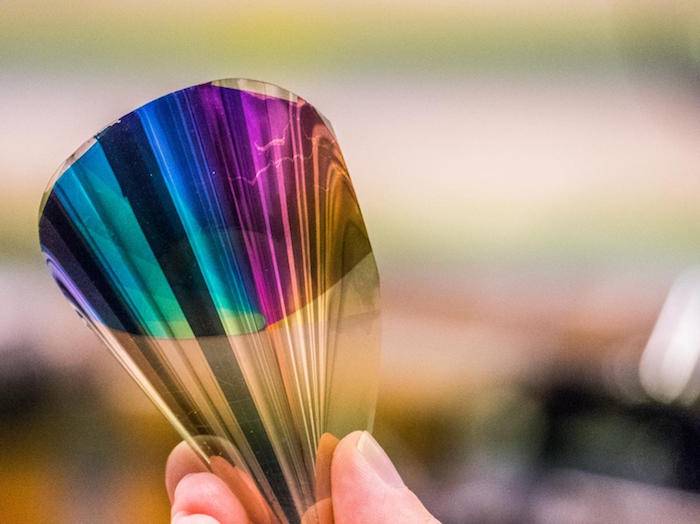
[Image above] Chalmers’ e-paper contains gold, silver, and PET plastic. The layer that produces the colors is less than a micrometer thin. Credit: Mats Tiborn
Thin, flexible, durable, and highly efficient—that’s the criteria for next-generation consumer electronics.
From lenses to speakers to electronic displays, researchers are hitting the pavement to develop devices that meet these benchmarks.
When it comes to developing ultrathin lenses, scientists at Australian National University (Canberra, Australia) may have changed the game. The team created what it describes as “the world’s thinnest lens, one two-thousandth the thickness of a human hair,” which could revolutionize flexible computer displays and miniature cameras, according to an ANU press release.
Other researchers are focused on fabricating thermo-acoustic speakers using ultra-thin graphene. Researchers at the Korea Advanced Institute of Science and Technology (KAIST) say they’ve developed an ultrathin, flexible graphene thermo-acoustic speaker that doesn’t create sound vibrations. Instead, it makes sound by rapidly heating and cooling the air around it—which negates the need for a stiff, boxy housing structure.
In August, KAIST researchers also made news with their novel ultrathin, transparent oxide thin-film transistors for wearable displays. The team fabricated “ultrathin and transparent oxide thin-film transistors for an active-matrix backplane of a flexible display by using the inorganic-based laser lift-off method,” according to a KAIST press release.
Also in the realm of ultrathin electronic displays, researchers at Chalmers University of Technology in Göteborg, Sweden, have developed the basis for a new electronic “paper” that is bendable, less than a micrometer thin, and transmits the same rich color spectrum of a typical LED display—and it requires ten times less energy to power it than a Kindle e-reader.
But similar to the Kindle, the electronic paper reflects external light to give it its illuminating qualities.
“The ‘paper’ is similar to the Kindle tablet,” lead researcher Andreas Dahlin explains in a Chalmers press release. “It isn’t lit up like a standard display, but rather reflects the external light which illuminates it. Therefore, it works very well where there is bright light, such as out in the sun, in contrast to standard LED displays that work best in darkness. At the same time, it needs only a tenth of the energy that a Kindle tablet uses, which itself uses much less energy than a tablet LED display.”
Through their work placing conductive polymers on nanostructures, Dahlin and his Ph.D. student Kunli Xiong realized the combination would be “perfectly suited to creating electronic displays as thin as paper,” the release explains.
But the paper’s ability to illuminate depends entirely on the polymers’ ability to control how light is absorbed and reflected.

Chalmers’ logotype shows how the RGB pixels can reproduce color images. The magnification shows which pixels are activated to create the image. Credit: Kunli Xiong
The technology works, the researchers explain, because the polymers that cover the surface of the paper transmit electric signals across the display area to create high resolution images. Through testing, Dahlin and Xiong built several pixels using the same red, green, and blue colors that standard LED displays use. And the goal is to scale up the process to build larger, thin displays.
“We are working at a fundamental level but even so, the step to manufacturing a product out of it shouldn’t be too far away. What we need now are engineers,” Dahlin adds.
The current process, however, requires gold and silver elements to make the electronic paper display work—precious metals that don’t equate to cost-efficient manufacturing.
“The gold surface is 20 nanometers thick, so there is not that much gold in it,” explains Dahlin. “But, at present, there is a lot of gold wasted in manufacturing it. Either we reduce the waste or we find another way to decrease the manufacturing cost.”
As far as potential applications go, Dahlin envisions this technology will be useful for displays used outside or in public places to display information. And because the electronic paper requires so little power, it could reduce energy consumption currently used for these types of signs.
The research, published in Advanced Materials, is “Plasmonic metasurfaces with conjugated polymers for flexible electronic paper in color” (DOI: 10.1002/adma.201603358).
Author
Stephanie Liverani
CTT Categories
- Electronics
- Energy
- Manufacturing
- Material Innovations


